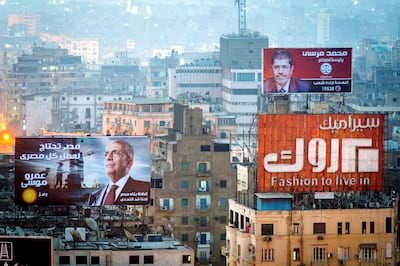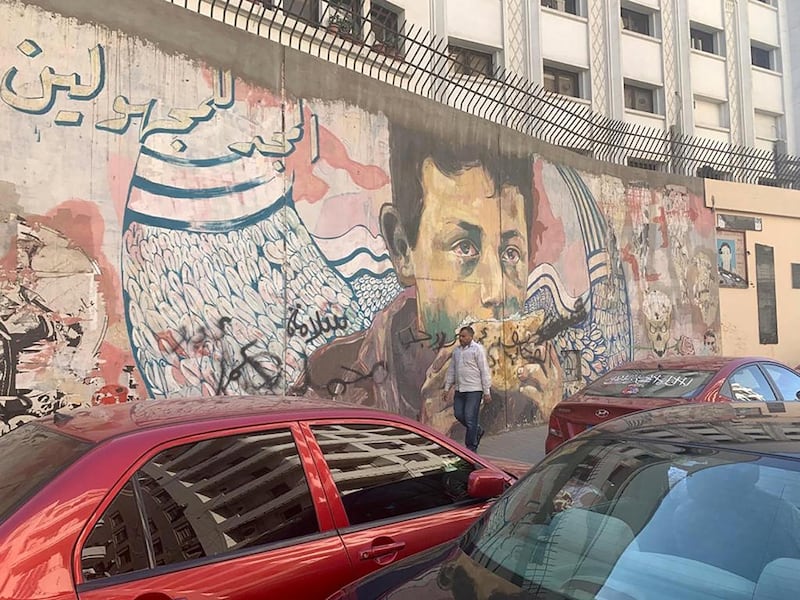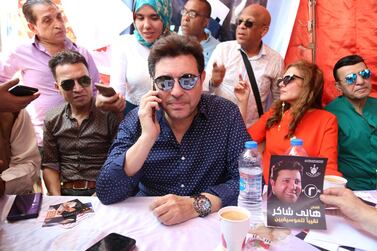Perhaps more than other world cities, walls and billboards in Cairo serve as a chronicle of the Egyptian capital’s recent history. For anything older, the city offers a dazzling array of historical sites, whose size and diversity are unlike anywhere else, from the Great Pyramids of Giza, Roman-era churches and medieval fortresses to Ottoman homes and Mameluke mosques that map the evolution of Cairo’s rich history.
In Downtown Cairo, art deco buildings speak of a frantic, late 19th-century drive to turn what was then a semi-rural city into a sprawling European metropolis. But the politics and the turmoil of recent years are documented, not by historical sites or breathtaking architecture, but by the graffiti and messages on hundreds of billboards that line roads in the Nile-side city, which is home to some 20 million people.
Many speak of ambitious mega projects undertaken by the country’s energetic president to build new cities — about 14 in total — which define his five-year rule, including a brand new capital in the desert east of Cairo.
They advertise high-end homes in walled communities in the new capital with fancy names like “La Verde” and “Vinci.” Prices start at one million pounds for a relatively small apartment, which is well beyond the reach of most Egyptians, even if paid in instalments. The large number of these housing advertisements mirrors the resolve of authorities to turn the new capital — a pet project of President Abdel Fattah El Sisi — into an urban planning success story for the world to see.
Other billboards speak of events from the recent past that remain relevant today.
One example is the billboards appealing to Egyptians to cast a “yes” vote in a referendum held last year on constitutional amendments that significantly broadened the president’s powers, giving him the option to stay in office until 2030. The “yes” vote won comfortably, enshrining these changes in the 2014 constitution, which had been billed by some as the most progressive ever in Egypt. Mr El Sisi, however, once dismissed it as a document written with good intentions, but not suited for nation building.
Other billboards bear an image of President Abdel Fatah El Sisi looking pensive, with the hint of a smile. They also declare the people’s continuing faith and trust in the Egyptian leader, the army and police. These sprang up across the city in response to a series of online videos by a businessman and actor living in self-imposed exile in Spain, in which he levelled corruption allegations against the Egyptian leader and the military. The videos went viral and hundreds of people answered the businessman’s call in September to protest against El Sisi’s rule, prompting mass detentions during the demonstrations and in subsequent weeks.

Not every depiction of Egypt's recent past endures. During the 18-day 2011 uprising that toppled the rule of authoritarian leader Hosni Mubarak, graffiti artists were prolific in chronicling the historic events reshaping the country's future. Like other artists in countries gripped by Arab Spring uprisings, they documented the mood on the streets during those momentous weeks and months. Most of that has now been whitewashed as part of the government's effort to stabilise the country and restore discipline and rule of law on the streets.
The disappearance of the graffiti also fits in the narrative peddled by pro-government media outlets, which demonise the uprising as a foreign plot designed to plunge Egypt into chaos.
Curiously, some graffiti has escaped the city’s white paint brushes and bears witness to those days of upheavals, political naivete and “martyrdom.” However, those left on main streets are of the benign variety, free from profanities or sharply-worded political messages.
One of these is a large mural on the wall of the American university’s downtown campus near Tahrir Square — the birthplace of the 2011 uprising. Depicting a young boy with an expression of heart-rending sadness and tearful eyes, it declares: “Glory be to the unknowns” in an apparent reference to some of the 800 protesters shot dead during the protests.
On side streets not too far away, tiny and fading graffiti serves as a reminder of the uprising’s revolutionary fervour, with bold messages that deliver direct and undiplomatic attacks on some of the country’s key institutions and their top figures.







